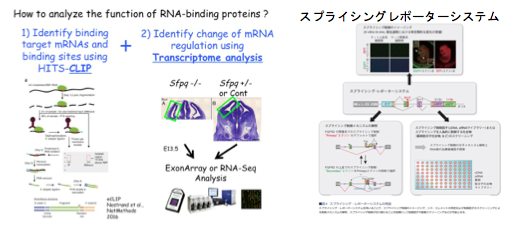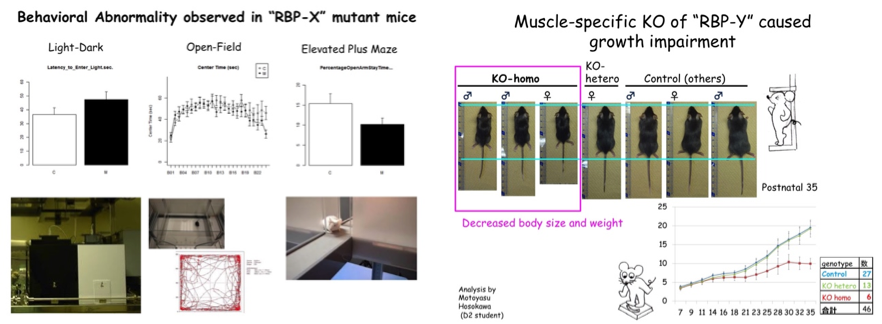RNA Biology
1. RNA-binding Proteins
A little over 1000 RNA-binding proteins exist in mammals, and they are known to bind to specific sequences and secondary structures (consensus sequence or structure) of RNA and carry out post-transcriptional control of transcribed RNA (alternative splicing, poly-A addition, mRNA stabilization and metabolism, transport, and translation control) to control diverse gene expressions. This mechanism is considered to be important in the nervous system and muscle tissues of higher animals with structure and functions that are highly complicated and specialized, but the complete picture as to how the mechanism actually works in various tissues and cells, and what it controls comprehensively is still not clear. We are closing in on this mystery with the following strategy.
2. RNAExpression Profiling of RNA-binding Proteins
There is very little information at present on the type of tissues and cells and the development stage timing of occurrence at which each RNA-binding protein is expressed. We are using the process of neurogenesis as a model to investigate the expression profile of all RNA-binding proteins, and by preparing and analyzing genetically modified mice with unknown RNA binding proteins, we are trying to elucidate which developmental processes in neurogenesis are controlled by RNA-binding proteins.

3. RNAAnalysis of RNA Control Mechanism
Each One RNA-binding protein simultaneously binds to multiple RNAs with the same recognition sequence (multiple targets) and multiple RNA-binding proteins further bind to one RNA and the multiple RNA-binding proteins themselves interact with each other on the RNAto and interact with each RNA-binding protein, and their function varies depending on the binding site and interacting molecules (context-dependent multiple functions) making it difficult to elucidate the function of the molecular groups. We are trying to get to the heart of the functions of RNA-binding proteins by combining HITS-CLIP (Immunoprecipitation and comprehensive sequence of RNA binding proteins-RNA complexes) that uses a next-generation sequencer, analysis of expression and control of RNA using RNA-Seq, and an original splicing reporter system developed by us.

4. RNAControl Abnormalities, Neurodegenerative Diseases, and Psychiatric Disorders
In the large-scale genome analysis of neurodegenerative diseases, hereditary muscle diseases, and psychiatric disorders carried out in recent years, mutations in many RNA-binding proteins are reported to be the candidate for causative genes of these diseases. By preparing genetically modified mice with these causative genes and observing their symptoms with behavioral analysis, and analyzing RNA control using the tissue samples, we are trying to elucidate the molecular pathology of neuromuscular diseases and psychiatric disorders that still have many mysteries to be solved.

